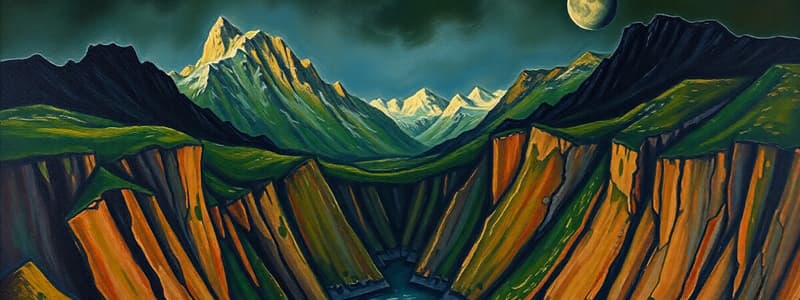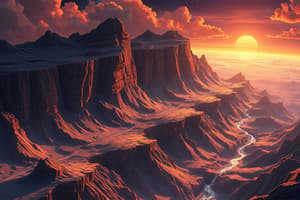Podcast
Questions and Answers
What are tectonic plates primarily composed of?
What are tectonic plates primarily composed of?
- Rocks that form the lithosphere (correct)
- Sedimentary soil
- Liquid magma
- Frozen water
Which layer of the Earth is cooler and more rigid?
Which layer of the Earth is cooler and more rigid?
- Lithosphere (correct)
- Outer core
- Inner core
- Asthenosphere
What defines a divergent plate boundary?
What defines a divergent plate boundary?
- Plates are splitting due to seismic activity
- Plates are sliding past each other without creating new crust
- Plates are colliding and mountains are formed
- Plates are pulling apart and new lithosphere is created (correct)
What process occurs at mid-ocean ridges?
What process occurs at mid-ocean ridges?
What is the primary driving mechanism behind the movement of tectonic plates in the asthenosphere?
What is the primary driving mechanism behind the movement of tectonic plates in the asthenosphere?
What type of stress is associated with divergent boundaries?
What type of stress is associated with divergent boundaries?
What is the term for the fractures in the crust that form due to tectonic stress?
What is the term for the fractures in the crust that form due to tectonic stress?
During seafloor spreading, what happens after new lava solidifies?
During seafloor spreading, what happens after new lava solidifies?
What process occurs when a continent splits into two divergent continents?
What process occurs when a continent splits into two divergent continents?
What evidence supports the theory of seafloor spreading?
What evidence supports the theory of seafloor spreading?
What is the main reason why oceanic crust sinks deeper into the mantle compared to continental crust?
What is the main reason why oceanic crust sinks deeper into the mantle compared to continental crust?
How do pillow basalts form?
How do pillow basalts form?
What primarily causes the uplift of mountain ranges at collision zones?
What primarily causes the uplift of mountain ranges at collision zones?
What is the role of the asthenosphere in continental rifting?
What is the role of the asthenosphere in continental rifting?
Why are many mountain ranges predominantly linear?
Why are many mountain ranges predominantly linear?
What happens to marine sediment thickness as distance from the mid-ocean ridge increases?
What happens to marine sediment thickness as distance from the mid-ocean ridge increases?
What geologic process primarily causes the formation of mountains in continental-continental collision zones?
What geologic process primarily causes the formation of mountains in continental-continental collision zones?
Which of the following is true about oceanic-continental subduction zones?
Which of the following is true about oceanic-continental subduction zones?
How does the melting snow from high mountains influence the surrounding environment?
How does the melting snow from high mountains influence the surrounding environment?
What is the primary force acting along transform plate boundaries?
What is the primary force acting along transform plate boundaries?
What phenomenon is responsible for creating hot spot trails?
What phenomenon is responsible for creating hot spot trails?
What is the elastic rebound theory in relation to earthquakes?
What is the elastic rebound theory in relation to earthquakes?
Which term describes the gap or weakness between two fault blocks?
Which term describes the gap or weakness between two fault blocks?
What happens at a continental-oceanic boundary during a subduction event?
What happens at a continental-oceanic boundary during a subduction event?
What phenomenon describes the behavior of faults that can lead to an earthquake?
What phenomenon describes the behavior of faults that can lead to an earthquake?
Which type of seismic wave travels the fastest during an earthquake?
Which type of seismic wave travels the fastest during an earthquake?
How do subduction zone earthquakes typically trigger tsunamis?
How do subduction zone earthquakes typically trigger tsunamis?
What characteristic of tsunamis allows them to travel across the ocean with minimal energy loss?
What characteristic of tsunamis allows them to travel across the ocean with minimal energy loss?
What is the primary function of an earthquake early warning system?
What is the primary function of an earthquake early warning system?
Which type of plate boundary is characterized by two tectonic plates moving apart?
Which type of plate boundary is characterized by two tectonic plates moving apart?
What type of volcano is primarily formed from low-silica magma and produces gentle eruptions?
What type of volcano is primarily formed from low-silica magma and produces gentle eruptions?
What process is commonly associated with the movement of tectonic plates at a transform boundary?
What process is commonly associated with the movement of tectonic plates at a transform boundary?
Flashcards
Tectonic Plates Composition
Tectonic Plates Composition
Tectonic plates are made of the Earth's lithosphere, which is the cool, strong, rigid crust and upper mantle.
Divergent Plate Boundary
Divergent Plate Boundary
A divergent plate boundary is where tectonic plates move apart, creating new lithosphere.
Divergent Boundary Location
Divergent Boundary Location
Divergent plate boundaries are often found at mid-ocean ridges and continental rifts.
Seafloor Spreading
Seafloor Spreading
Signup and view all the flashcards
Mid-Ocean Ridge
Mid-Ocean Ridge
Signup and view all the flashcards
Tectonic plates motion
Tectonic plates motion
Signup and view all the flashcards
Asthenosphere
Asthenosphere
Signup and view all the flashcards
Extensional Stress
Extensional Stress
Signup and view all the flashcards
Seafloor Spreading Evidence
Seafloor Spreading Evidence
Signup and view all the flashcards
Continental Rifting
Continental Rifting
Signup and view all the flashcards
Continental vs. Oceanic Crust Density
Continental vs. Oceanic Crust Density
Signup and view all the flashcards
Mountain Formation
Mountain Formation
Signup and view all the flashcards
Convergent Plate Boundaries
Convergent Plate Boundaries
Signup and view all the flashcards
Fissure Eruptions
Fissure Eruptions
Signup and view all the flashcards
Continental Collision
Continental Collision
Signup and view all the flashcards
Continental-Continental Collision
Continental-Continental Collision
Signup and view all the flashcards
Collision Zone Formation
Collision Zone Formation
Signup and view all the flashcards
Thrust Faulting
Thrust Faulting
Signup and view all the flashcards
Subduction Zone Components
Subduction Zone Components
Signup and view all the flashcards
Volcanic Activity and Subduction
Volcanic Activity and Subduction
Signup and view all the flashcards
Elastic Rebound Theory
Elastic Rebound Theory
Signup and view all the flashcards
Mantle Plumes and Hot Spots
Mantle Plumes and Hot Spots
Signup and view all the flashcards
Sea Mounts and Atolls
Sea Mounts and Atolls
Signup and view all the flashcards
Stick-Slip Behavior
Stick-Slip Behavior
Signup and view all the flashcards
Earthquake Cycle
Earthquake Cycle
Signup and view all the flashcards
Types of Seismic Waves
Types of Seismic Waves
Signup and view all the flashcards
Tsunami Trigger
Tsunami Trigger
Signup and view all the flashcards
Tsunami Traits
Tsunami Traits
Signup and view all the flashcards
Earthquake Early Warning
Earthquake Early Warning
Signup and view all the flashcards
Continental Drift
Continental Drift
Signup and view all the flashcards
Plate Tectonics
Plate Tectonics
Signup and view all the flashcards
Study Notes
Tectonic Plates
- Tectonic plates are composed of rock, shaped like slabs, forming Earth's outer surface
- Geologic boundaries (earthquakes, volcanoes, and seafloor features) often do not coincide with continental boundaries
- Tectonics involve large-scale, slow-motion movement and deformation
- Lithosphere encompasses the crust and upper mantle (approximately 100 km deep)
- It's cool, strong, and rigid
- Asthenosphere is the upper mantle, ranging from 400-600 km deep
- It's hot and plastic-like, with different strengths compared to the lithosphere
- It flows by convection
Divergent Plate Boundaries
- Marked by mid-ocean ridges and continental rifts
- Characterized by extensional stress
- Seafloor spreading creates new lithosphere
- Magma wells up, emerging onto the seafloor
- Rift valleys/axial rift form
- Plates pull apart along an axis, causing brittle crust to fracture along ridges and faults
- Faults are planes of weakness where rock breaks, and abrupt movements occur due to tectonic stress
- Fractures are cracks without movement
- Continued plate extension occurs at mid-ocean ridges, splitting and displacing new oceanic lithosphere
- New lava solidifies, then is fractured
- Fractures are planar
- Cracks/fissures within a body of rock with no movement along planar surface
Seafloor Spreading Evidence
- Observation and measurements of the seafloor
- Dredging and drilling
- Marine sediment thickness
- Maps of earthquake distribution associated with mid-ocean ridges
- Heat flow (highest over mid-ocean ridges and decreases away from ridges)
- Submersibles and remote vehicles used for exploration of axial rifts
Continental Rifting
- Ocean basins form when continents split
- Upwelling asthenosphere beneath continents pushes overlying lithosphere, causing it to stretch and break along faults
- Collapse of fault blocks creates rift valleys
- As lithosphere stretches and thins, underlying asthenosphere rises more, melts, and creates magma/volcanoes
Continental Crust and Oceanic Crust
- Oceanic crust is denser than continental crust, and therefore floats lower.
- Continental crust floats like icebergs, thus continental-continental collisions don't involve subduction due to different density
Mountain Formation
- Mountains frequently form in linear patterns from continent-continent collisions
- Convergent plate boundaries are classified as continental-continental, continental-oceanic, and oceanic-oceanic.
Convergent Plate Boundaries
- Continental-Continental: Collision zones, with no subduction, creating mountains like the Himalayas and European Alps. Thrust faulting occurs with thick rock layers detaching and moving slowly.
- Continental-Oceanic: Oceanic plate subducts beneath the continental plate (e.g., Andes Mountains), creating volcanic chains.
- Oceanic-Oceanic: One oceanic plate subducts beneath the other, creating volcanic island arcs.
Transform Plate Boundaries
- Transform plate boundaries create earthquakes along faults, involving the displacement of massive rock blocks.
- Planar weaknesses may appear between two fault blocks, but they are not related to tectonic plates.
- Occurs along faults where massive rock blocks and surface features offset
Other Topics
- Causes and types of earthquakes, including recurrence intervals, focus vs. epicenter, and displacement
- Seismic waves: P waves, S waves, Love waves, Raleigh waves
- Earthquakes and tectonic settings
- Important events
- Describing volcanic events, including the influence of silica on magma type
Studying That Suits You
Use AI to generate personalized quizzes and flashcards to suit your learning preferences.




